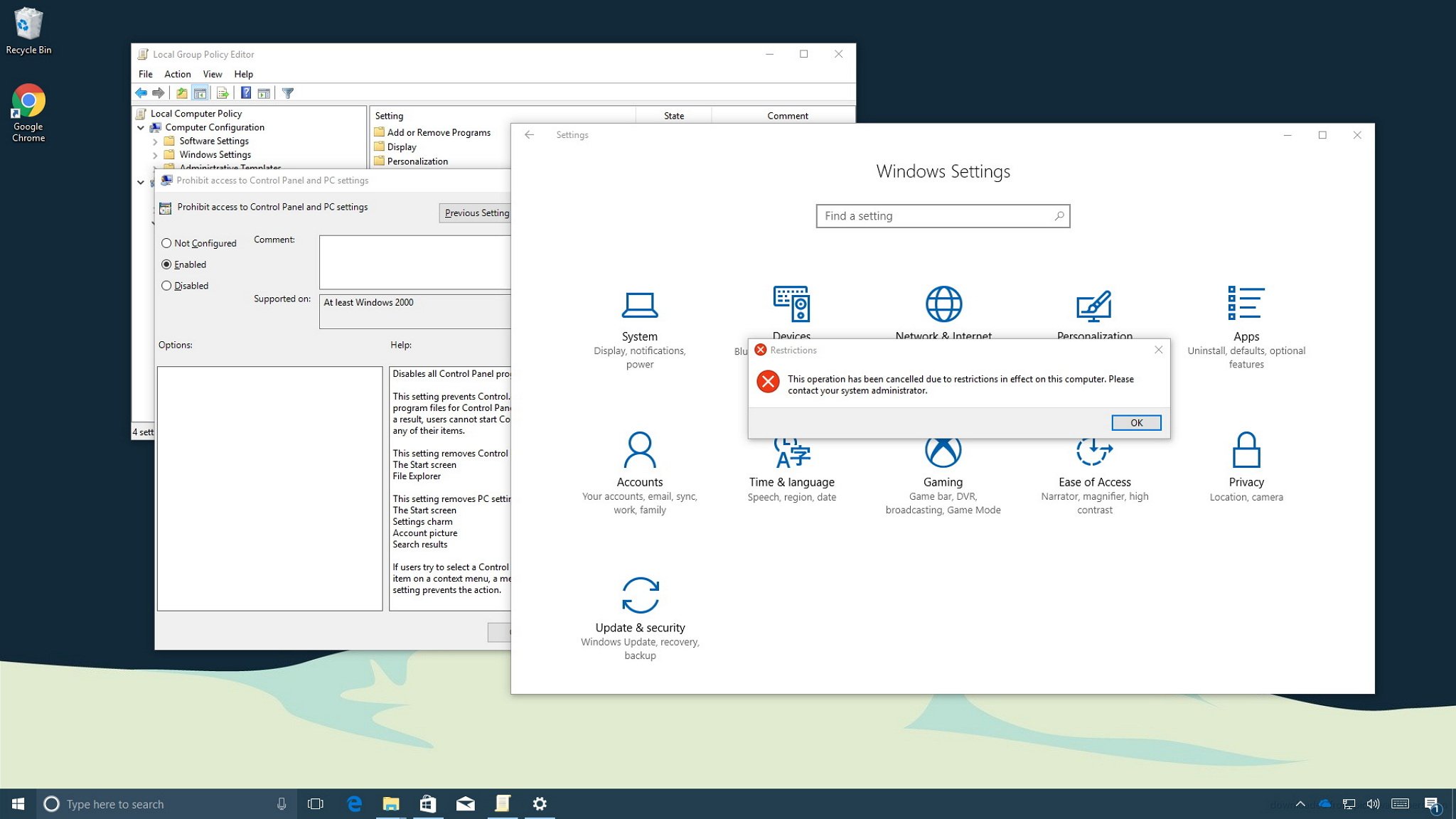How to disable access to Windows 10's Settings app and Control Panel
If you want to stop users from changing settings in Windows 10, this guide shows you how to block access to the Settings app and Control Panel.

In Windows 10, the Settings app, along with the Control Panel, lets you change a wide range of settings to customize your experience, and change system, network, account, and privacy settings.
However, if you're a network administrator for an organization, or you share your PC with other people, you know that letting non-technical users access settings will often result in misconfigurations.
If you don't want anyone altering the settings on your computer, in Windows 10 you can quickly prevent this by disabling access to the Settings app and the Control Panel using the Local Group Policy Editor and the Registry. This not only ensures your configurations will be preserved all the time, but it also helps stop users from modifying settings accidentally.
In this Windows 10 guide, we walk you through the steps to restrict access to the Settings app and Control Panel on your computer.
- How to disable Settings and Control Panel using Group Policy
- How to disable Settings and Control Panel using Registry
How to disable Settings and Control Panel using Group Policy
If your PC is running Windows 10 Pro (or Enterprise), the easiest way to restrict access to the Settings app and the Control Panel is to use the Local Group Policy Editor.
To disable Settings and Control Panel using Group Policy, do the following:
- Use the Windows key + R keyboard shortcut to open the Run command.
- Type gpedit.msc and click OK to open the Local Group Policy Editor.
- Browse the following path:
User Configuration > Administrative Templates > Control Panel - On the right side, double-click the Prohibit access to Control Panel and PC settings policy.
- Select the Enabled option.
- Click Apply.
- Click OK.
After you complete these steps, users won't be able to open the Settings app, and those who try to open the Control Panel will ee this message: "This operation has been canceled due to restrictions in effect on this computer. Please contact your system administrator."
All the latest news, reviews, and guides for Windows and Xbox diehards.
If you want to change the settings back, you can always use the same instructions, but on step No. 5, make sure to select the Not Configured option.
How to disable Settings and Control Panel using Registry
If you're running Windows 10 Home, you won't have access to the Local Group Policy Editor, but you can still block users from accessing the Settings app and Control Panel on Windows 10 by modifying the Registry.
Warning: This is a friendly reminder that editing the registry is risky, and it can cause irreversible damage to your installation if you don't do it correctly. We recommend to making a full backup of your PC before proceeding.
To prevent users from changing settings on Windows 10 using the Registry, do the following:
- Use the Windows key + R keyboard shortcut to open the Run command.
- Type regedit, and click OK to open the Registry.
- Browse the following path:
HKEY_CURRENT_USER\Software\Microsoft\Windows\CurrentVersion\Policies\Explorer - Right-click on the right side, select New, and then click on DWORD (32-bit) Value.
- Name the key NoControlPanel and press Enter.
- Double-click the newly created DWORD and set the value from 0 to 1.
- Click OK.
Once you complete these steps, users won't be able to open the Settings app, and those who try to open the Control Panel will see this message: "This operation has been canceled due to restrictions in effect on this computer. Please contact your system administrator."
At any time you can revert the changes by following the same steps, but this time in step No. 6, make sure to switch the value from 1 to 0.
Wrapping things up
Although this feature is particularly useful in a network environment, such as when configuring a kiosk or guest machine, there are many other scenarios where disabling the Settings app and the Control Panel will come in handy too.
For example, if you share a device in the house with children, and you don't want them messing around with the settings on Windows 10. It's also helpful if you're the tech support person for your family and friends, and they keep calling you to reconfigure a feature over and over again. You can fix their computer once, and then block them access to change settings, so you get fewer support calls.
If you're a network administrator, and you're simply looking to block users from accessing particular settings, you can use our guide with the steps to restrict access to pages in the Settings app on Windows 10.
While this guide focused on Windows 10, you can use the same instructions on Windows 8.1. If you want to disable the Control Panel on Windows 7, you can still use these steps, but the policy is called Prohibit access to the Control Panel and the Registry is also called NoControlPanel.
More Windows 10 resources
For more help articles, coverage, and answers to common questions about Windows 10, visit the following resources:
- Windows 10 on Windows Central – All you need to know
- Windows 10 help, tips, and tricks
- Windows 10 forums on Windows Central

Mauro Huculak has been a Windows How-To Expert contributor for WindowsCentral.com for nearly a decade and has over 22 years of combined experience in IT and technical writing. He holds various professional certifications from Microsoft, Cisco, VMware, and CompTIA and has been recognized as a Microsoft MVP for many years.




